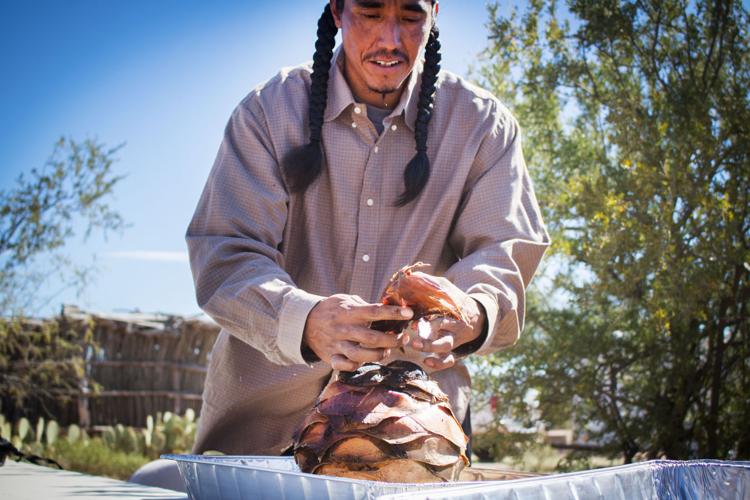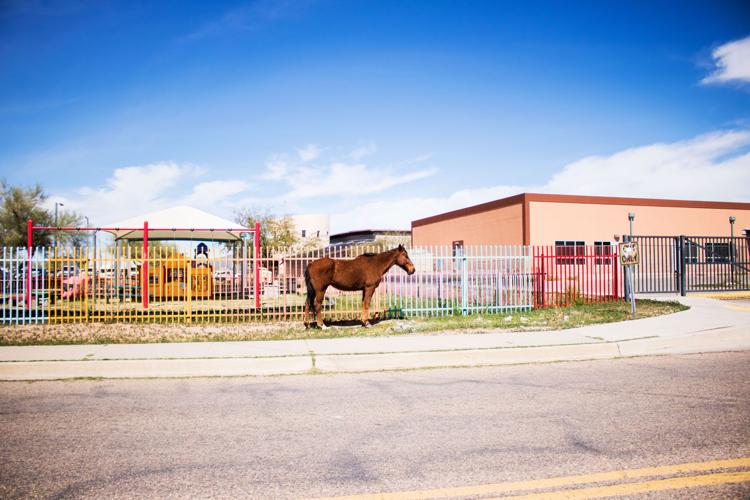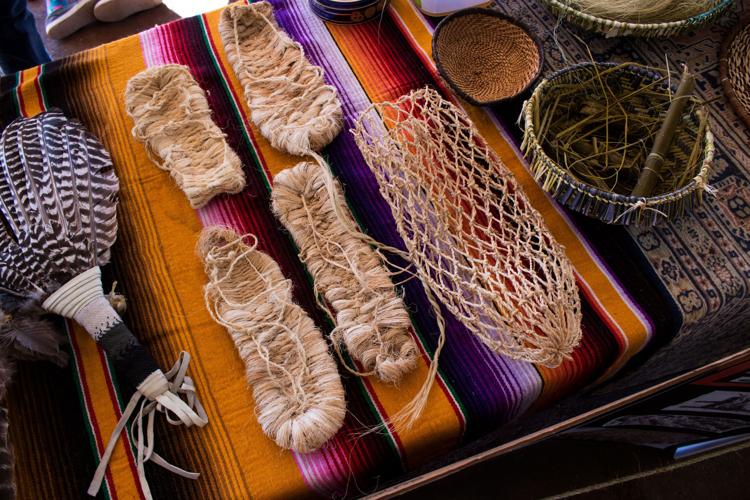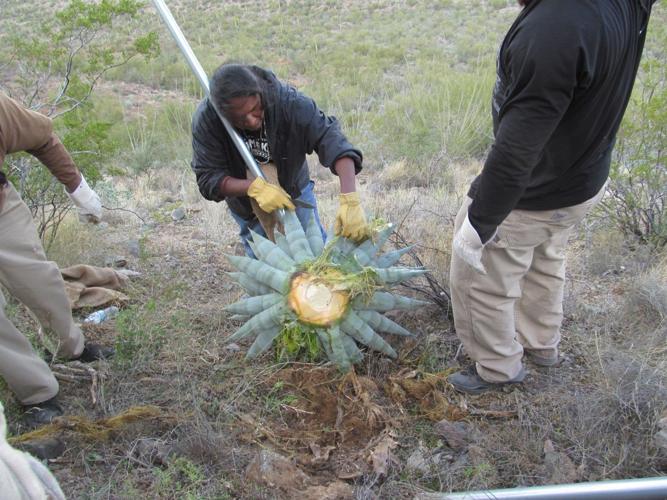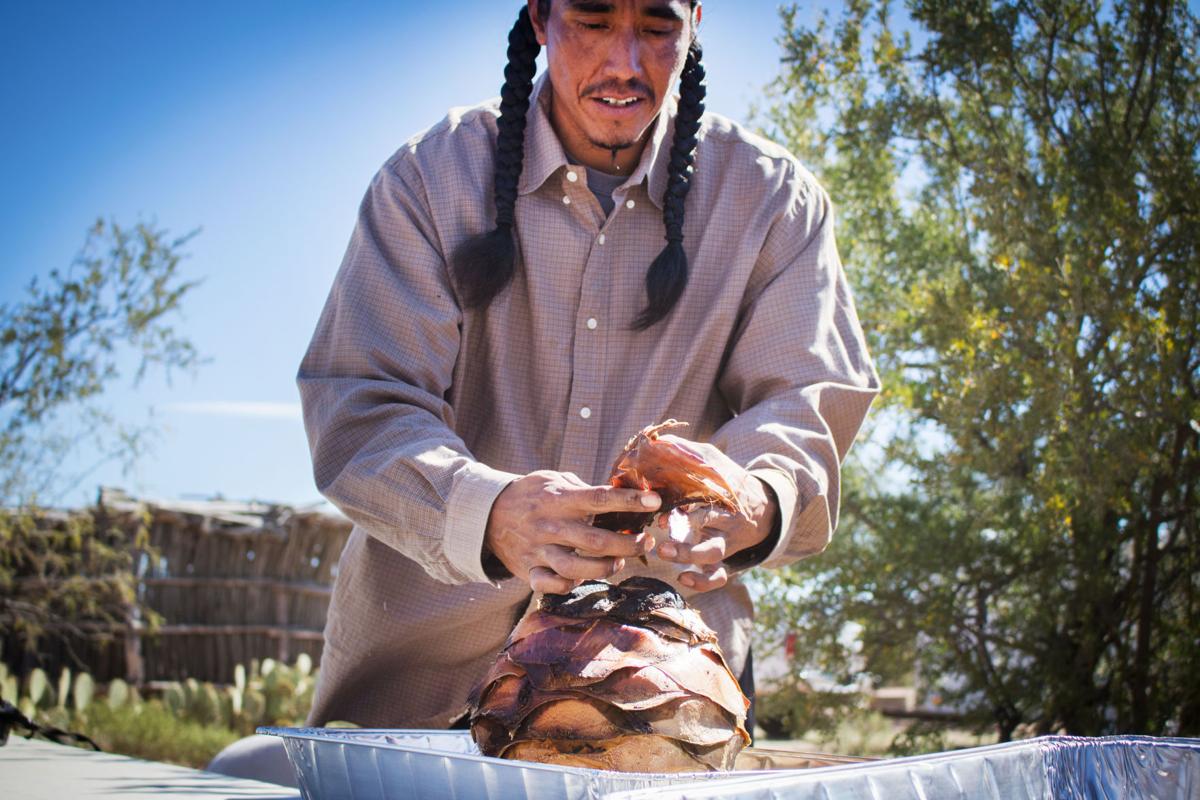It was hard to find on a map. So I asked the voice over the phone to give me detailed directions to Topawa, a little desert town about seven miles south of Sells on the Tohono O'Odham Nation.

Driving through the capital of Sells on the way to Topawa.
Bernard Siquieros knew it well. He had a friendly voice while he recited the turnoffs, but he didn't seem very talkative or overly accommodating, like people who often deal with the press can be. He'd just turned me down after all, so I had to beg to get what I wanted.
I wanted to see a thousand-year-old roast. Since the days of the Hohokam, Arizonans have survived off the spiny succulents of the desert. They eat the agave like it's candy, I'd heard. But the practice of roasting agave is very rare, in fact the Tohono O'Odham only do it once a year. Probably because the process takes several days and is unbelievably labor-intensive.

A roasted agave heart looks kind of like a pineapple, but it's much more bitter and vegetal.
Since the event took place during an archaeology conference that was open to the public, I was allowed to see the ceremonial ending when the agave hearts are taken out of the underground oven. ("It's kind of like a big crock pot," one man told me.) But I wasn't able to get permission to see them harvest the plant with machetes. To do this, a group of men in the nation's Fatherhood program hike up to a spot near the Silver Bell Mine west of Marana, which is the only place on the 4,000-square-foot reservation where this species of agave grows wildly.
They call the mountain A'ud — which is also their name for agave — the men later told me. Here are some pictures they sent me to show how it's done:

The agave in its natural state, before it's harvested.
They take the agave just before it's about to send up a flower stalk, because that's when it's the sweetest.
“We’ll go at the hike, some miles up, two at the most, and cut 'em down with these poles here," said a member of the team Jerald Josay. "Then we put them in our gunnysacks and bring 'em down. That’s kind of the hard part, cause you’re trying to balance and you’ve got weight and it’s real steep."
“(This year) they were barely coming up, they were too small. So we had to go higher to where nobody had climbed before to get our agave. It was a journey. It was kind of dangerous, it was kind of scary, but it was worth it."

After the roots are cut away, the agave is placed upside down in a sack so it's easier to carry.
The agaves are taken back to camp and stripped of their leaves, so that only the heart, or piña remains. The leaves can be woven into fibers and used in baskets and sandals.

Nearby at the cultural center, Hualapai women showed us how to weave baskets and sandals out of yucca fibers.
When I arrived at the conference and walked past the spiffy Tohono O’odham Nation Cultural Center through a canopy of desert plants into a clearing, the men were milling around their tents. They had been camping out here for the past three days, checking their dirt oven once every hour. If a spot feels hot or has steam coming out of it, they throw some more dirt on there to cover it up and keep the heat in.

Fatherhood members standing in front of their agave pit, from left: Samuel Fayuant, Norbert Wilson, Jerald Josay and Angel Moreno.
At 10 a.m. the archaeologists arrived and we were ready to start. Bernard explained that the group of men had dug a conical pit about three feet deep. They lined the pit with mesquite branches and boulders from nearby. Then they set the branches on fire, to turn the boulders into coals that would power the oven.
Once they broke up the boulders into little rocks, they threw in a dozen agave hearts, some as big as bowling balls. (If a person had ever been "bit by a spider, stung by a scorpion or burnt by a fire," they were not allowed to put the agave on the coals, Bernard said.)
Next they covered everything with water-soaked red grass, lined the corners with a tarp and covered the hole with dirt. Then they let the sun do its thing.
Ready, set go!

Volunteers helped to shovel out the pit. The man in the purple jacket standing on the right is the elder, Jose Enriquez, who was taught to harvest agave by his grandparents.

Volunteers pull the tarp out of the pit.

Agave lining the pit, which is four-feet-wide and three-feet-deep.
A few feet away stood a group of Hualapai tribal members, who had come down here from Peach Springs in northwestern Arizona. They had set up their own agave roast, using smaller hearts the size of "softballs." They lined their pit with juniper bark rather than mesquite, and threw in strings of barrel cactus and elk meat from one of the men's first-kill.

Barrel cactus inside the Hualapai's pit a few feet away.
The agave hearts were collected and put in a silver tub and set onto a white picnic table, filling the air with the roasty sweet smell of charred earth. Everyone gathered around. Then they got out their knives and started to cut ...

Agave hearts in the tub, right before they were eaten.

A smaller agave heart from the Hualapai in Peach Springs.
Bernard handed me a piece. It was sticky in my hand and reminded me of the springy sugarcane you get with those fried shrimp dumplings at Gee's Garden. It tasted like a squash, or what I imagine bitter melon to be.
Lots of pieces were being passed around. Some were syrupy sweet, some were bitter, some were earthy like biting into a mesquite bean. Some pieces you just sucked on. Some pieces you ate.

A piece of the heart that had been peeled off, kind of like an artichoke.
It's not a meal though. It's a treat. And so afterwards I followed the crowd back around the cultural center, to one of those lines that gather every time you see someone frying up a big tin of oil.

And now, the main course ... Fry bread!
"Welcome to Mexico," the guy working the line said as he spooned a spicy mound of red chile beef onto my fry bread. I wasn't really sure what that meant, but I figured, we were pretty close ...
Then I took a bite, and drank my soda, and felt glad to be right here in Arizona.


